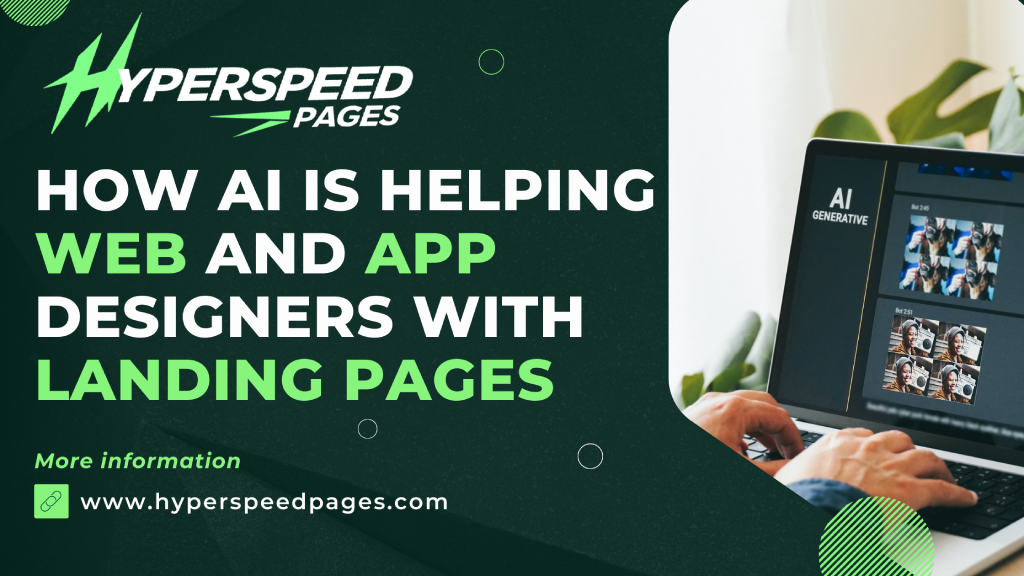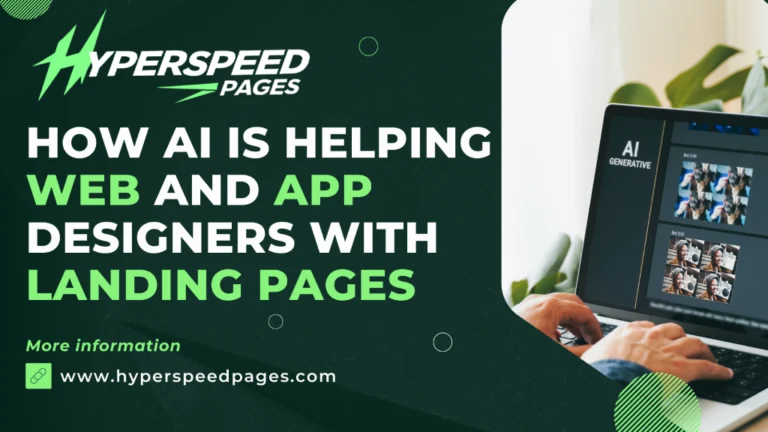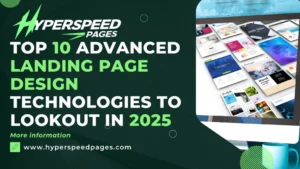
As technology continues to advance, the role of Artificial Intelligence (AI) in web and app design is becoming increasingly significant. One area where AI is making a substantial impact is in the creation of landing pages.
The Importance of Landing Pages
A landing page is a critical component of any digital marketing strategy. It’s a dedicated page designed to convert visitors into customers, subscribers, or leads. A well-crafted landing page can make all the difference in driving sales, generating revenue, and growing a business.
The Challenges of Traditional Landing Page Design
Creating an effective landing page can be a daunting task, even for experienced designers. The process typically involves:
- Research: Conducting market research, analyzing competitors, and identifying target audiences.
- Design: Crafting a visually appealing design that resonates with the target audience.
- Content creation: Writing compelling copy that drives conversions.
- Testing and optimization: Iteratively testing and refining the landing page to improve performance.
This process can be time-consuming, requiring significant resources and expertise. Moreover, the success of a landing page is often dependent on various factors, such as the quality of the design, the relevance of the content, and the effectiveness of the call-to-action (CTA).
Why Landing Pages Matter in the Digital Age
A landing page is often the first point of contact between a user and a brand. It serves a specific purpose—whether it’s to capture leads, promote a product, or drive conversions.
However, designing an effective landing page is no easy feat. It requires a deep understanding of user behavior, aesthetics, functionality, and performance optimization. This is where AI steps in, offering innovative solutions to age-old design challenges.
How AI is Transforming Landing Page Design
1. Personalization at Scale
One of the most significant advantages of AI is its ability to deliver personalized experiences. By analyzing user data such as browsing history, demographics, and preferences, AI can dynamically tailor landing page content to individual users.
For example, AI-powered tools like Optimizely and Unbounce use machine learning algorithms to test different versions of a landing page in real-time. These tools can automatically adjust headlines, images, and calls-to-action (CTAs) based on what resonates most with each visitor.
Technical Insight: AI algorithms use A/B testing and multivariate testing to identify patterns in user behavior. Over time, these algorithms learn which design elements perform best, enabling designers to create highly targeted landing pages.
2. Automated Design Generation
AI is making it easier than ever to create visually stunning landing pages without starting from scratch. Tools like Wix ADI (Artificial Design Intelligence) and Bookmark’s AIDA use AI to generate custom designs based on user inputs.
Simply answer a few questions about your brand, target audience, and goals, and these tools will produce a fully functional landing page in minutes. This not only saves time but also ensures that the design aligns with best practices for user experience (UX) and conversion rate optimization (CRO).
Creative Tip: While AI-generated designs are a great starting point, designers can add their unique touch by customizing layouts, fonts, and color schemes to reflect the brand’s identity.
3. Enhanced User Experience with Predictive Analytics
AI’s predictive capabilities are revolutionizing how designers approach UX. By analyzing vast amounts of data, AI can predict user behavior and suggest design improvements that enhance usability and engagement.
For instance, AI tools like Hotjar and Crazy Egg provide heatmaps, scroll maps, and click maps that reveal how users interact with a landing page. Designers can use this data to optimize the placement of CTAs, reduce friction points, and improve overall navigation.
Technical Insight: Predictive analytics relies on machine learning models that process historical data to forecast future outcomes. These models can identify trends and anomalies, helping designers make data-driven decisions.
4. Voice and Visual Search Optimization
As voice and visual search gain popularity, AI is helping designers optimize landing pages for these emerging technologies. AI-powered tools like Google’s Vision AI and Amazon Rekognition can analyze images and videos, making it easier to incorporate visual search functionality into landing pages.
Similarly, natural language processing (NLP) algorithms enable voice search optimization by understanding and responding to user queries in real-time.
SEO Tip: To optimize for voice search, focus on long-tail keywords and conversational phrases. For visual search, use high-quality images with descriptive alt text and metadata.
5. Real-Time Performance Monitoring and Optimization
AI doesn’t just help with the design process—it also ensures that landing pages perform optimally over time. Tools like Google Analytics 4 (GA4) and Adobe Target use AI to monitor key performance metrics such as bounce rate, time on page, and conversion rate.
If a landing page underperforms, these tools can automatically suggest or implement changes to improve results. For example, AI might recommend shortening the page load time, simplifying the form fields, or adjusting the color contrast for better readability.
Technical Insight: AI-driven performance monitoring relies on real-time data processing and anomaly detection. By continuously analyzing user interactions, AI can identify issues before they impact the overall user experience.
6. Dynamic Content Generation with Natural Language Processing (NLP)
AI-powered NLP tools like OpenAI’s GPT-4 and Jasper AI are revolutionizing how landing page content is created. These tools can generate compelling headlines, product descriptions, and even entire paragraphs tailored to a specific audience.
For example, if you’re designing a landing page for an e-commerce brand, AI can analyze customer reviews, product details, and competitor content to craft persuasive copy that drives conversions. This not only saves time but also ensures that the messaging aligns with user intent and search engine optimization (SEO) best practices.
Technical Insight: NLP models are trained on vast datasets of text, enabling them to understand context, tone, and semantics. This allows them to generate human-like content that resonates with users.
7. AI-Powered Image and Video Optimization
Visual content plays a crucial role in landing page design, and AI is making it easier to optimize images and videos for both performance and engagement. Tools like Adobe Sensei and Canva’s Magic Resize use AI to automatically resize, crop, and enhance visuals based on the platform and device.
Additionally, AI can analyze user interactions with visual content to determine which images or videos perform best. For instance, if users tend to engage more with videos than static images, AI can recommend incorporating more video content into the landing page.
Creative Tip: Use AI tools to create personalized visuals, such as dynamically generated product images or videos that feature the user’s name or location.
8. Intelligent Chatbots for Real-Time Engagement
AI-driven chatbots are becoming a staple on landing pages, providing instant support and guiding users through the conversion funnel. Tools like Drift and Intercom use machine learning to understand user queries and deliver personalized responses.
For example, if a user is hesitant to complete a purchase, a chatbot can offer a discount code or answer frequently asked questions in real-time. This not only improves user experience but also increases the likelihood of conversion.
Technical Insight: Chatbots leverage NLP and sentiment analysis to understand user intent and emotions. Over time, they learn from interactions to provide more accurate and helpful responses.
9. AI-Driven Accessibility Enhancements
Accessibility is a critical aspect of landing page design, and AI is helping designers create inclusive experiences for all users. Tools like AccessiBe and UserWay use AI to automatically adjust landing pages for accessibility standards, such as screen reader compatibility, keyboard navigation, and color contrast.
AI can also analyze user behavior to identify accessibility issues. For instance, if users with visual impairments frequently abandon a page, AI can suggest design changes to improve readability and usability.
SEO Tip: Accessible landing pages not only improve user experience but also rank higher in search engines, as accessibility is a key factor in Google’s algorithm.
10. Predictive Lead Scoring and Conversion Optimization
AI is transforming how landing pages capture and qualify leads. Predictive lead scoring tools like HubSpot’s AI Features and Salesforce Einstein analyze user behavior to determine the likelihood of conversion.
For example, if a user spends a significant amount of time on a pricing page or downloads a whitepaper, AI can assign them a high lead score and trigger personalized follow-up actions, such as sending an email or displaying a targeted CTA.
Technical Insight: Predictive lead scoring uses machine learning algorithms to analyze historical data and identify patterns that correlate with high-value leads. This enables designers to create landing pages that prioritize the most promising prospects.
11. AI-Enhanced A/B Testing and Multivariate Testing
Traditional A/B testing can be time-consuming and limited in scope. AI-powered testing tools like VWO and Convert take experimentation to the next level by automating the process and analyzing results in real-time.
These tools can test multiple variables simultaneously, such as headlines, images, CTAs, and layouts, to determine the optimal combination for maximum conversions. AI can also identify subtle trends that humans might miss, such as the impact of micro-interactions on user engagement.
Creative Tip: Use AI-driven testing to experiment with unconventional design elements, such as animations, interactive features, or gamification.
12. Emotion Detection for Hyper-Personalization
AI is now capable of detecting user emotions through facial recognition, voice analysis, and behavioral data. Tools like Affectiva and Emotion AI can analyze how users react to a landing page and adjust the design in real-time to evoke positive emotions.
For example, if a user appears frustrated while filling out a form, AI can simplify the process or display a reassuring message. This level of hyper-personalization creates a more empathetic and engaging user experience.
Technical Insight: Emotion detection relies on computer vision and deep learning algorithms to interpret facial expressions, voice tones, and other behavioral cues.
The Role of AI in App Design
While much of this blog focuses on web design, it’s worth noting that AI is equally transformative in app design. Mobile apps often rely on landing pages for onboarding, promotions, and updates. AI-powered tools like Figma’s Auto Layout and InVision Studio are helping app designers create responsive, user-friendly interfaces that adapt to different screen sizes and devices.
Ethical Considerations and Challenges
As with any technology, the use of AI in design comes with ethical considerations. Designers must ensure that AI-generated content is transparent, unbiased, and respectful of user privacy. Additionally, over-reliance on AI could stifle creativity, so it’s crucial to strike a balance between automation and human input.
The Future of AI in Landing Page Design
The integration of AI into web and app design is still in its early stages, but the potential is limitless. In the future, we can expect:
- AI-Driven Content Creation: Tools that generate not just designs but also copywriting and multimedia content.
- Advanced Personalization: Hyper-targeted landing pages that adapt to user emotions and intent.
- Immersive Experiences: AI-powered augmented reality (AR) and virtual reality (VR) elements that take user engagement to the next level.
AI is no longer a futuristic concept—it’s a practical tool that’s reshaping the way designers approach landing pages. As the digital landscape continues to evolve, staying informed about AI trends and technologies will be key to maintaining a competitive edge.




